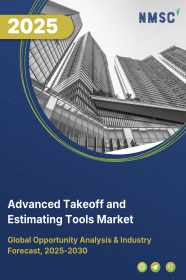
Advanced Takeoff and Estimating Tools Market by Deployment Type (Cloud-Based Solutions and On-Premises Solutions), by Application (Cost Estimation, Material Takeoffs, Project Scheduling, and Budget Tracking), by Enterprise Size (Large Enterprises and Small and Medium Enterprises (SMEs)), and by End User (Construction Companies, Engineering Firms, Architectural Firms, and Real Estate Developers)-Global Opportunity Analysis and Industry Forecast 2025-2030
US Tariff Impact on Advanced Takeoff and Estimating Tools Market
Trump Tariffs Are Reshaping Global Business
Advanced Takeoff and Estimating Tools Market Overview
The global Advanced Takeoff and Estimating Tools Market size was valued at USD XX billion in 2024 and is predicted to reach USD XXX billion by 2030 with a CAGR of XX% from 2025-2030. The market is experiencing steady growth driven by the construction industry's growing demand for accuracy, efficiency, and cost control.
As project complexity increases and margins tighten, contractors are turning to digital solutions to streamline estimating processes, minimize errors, and improve bid competitiveness. These tools enable faster and more precise quantity takeoffs, helping firms manage project risks and optimize budgeting.
However, adoption is challenged by high initial investment costs, particularly for smaller firms with limited resources. On the contrary, opportunities remain strong, especially in developing more intuitive, integrated platforms that support seamless collaboration across commonly used construction software, ultimately making these tools more accessible to a broader range of users.
Rising Demand for Accuracy and Efficiency Drives Market Expansion
A significant driver in the advanced takeoff and estimating tools market demand is the continuous need for enhanced accuracy and efficiency in construction projects. Traditional manual takeoff methods are time-consuming and prone to human error, leading to inaccurate bids and potential cost overruns.
Advanced takeoff software enables estimators to perform quantity takeoffs from digital plans with greater speed and precision. For instance, software solutions can automatically calculate material quantities, reducing the chances of miscalculations. This improved accuracy directly translates to more competitive and profitable bids for contractors.
Furthermore, features like automated counting and measurement tools significantly accelerate the estimation process, allowing estimators to handle more projects in less time, thereby boosting overall efficiency. Several software providers, such as Bluebeam Revu, offer features that allow for precise digital measurements and markups, enhancing the accuracy of quantity takeoffs.
Focus on Cost Control and Risk Management Drives Advanced Takeoff and Estimating Tools Market Growth
Another crucial driving factor for the growth potential of advanced estimating tools is the increasing emphasis on cost control and risk management within the construction industry. Construction projects are often characterized by tight margins and numerous potential risks, making accurate cost estimation paramount.
Advanced takeoff and estimating software provide detailed insights into project costs by enabling precise material quantification and labor estimations. By leveraging these tools, contractors can develop more accurate budgets, identify potential cost risks early in the project lifecycle, and make informed decisions to mitigate them.
Some software even integrates with project management and accounting systems, providing a holistic view of project finances. This capability allows for better tracking of expenses against the initial estimates, facilitating proactive cost management and ultimately contributing to improved project profitability.
Increasing Project Complexity Fuels the Advanced Takeoff and Estimating Tools Market Expansion
The rising complexity of modern construction projects serves as a strong driver for the adoption of advanced takeoff and estimating tools. Today's projects often involve intricate designs, diverse materials, and complex building systems. Manually estimating quantities and costs for such projects can be exceptionally challenging and error-prone.
Advanced software solutions are equipped to handle these complexities by allowing estimators to work with detailed 2D and 3D models, extract accurate quantities for various components, and account for intricate project requirements.
The integration of BIM workflows with takeoff software, as offered by solutions like Autodesk Takeoff, enables estimators to directly derive quantities from the 3D model, reducing the risk of overlooking critical elements and improving the overall accuracy of the estimate. This ability to effectively manage the complexities of modern construction is a key reason for the increasing reliance on these advanced tools.
High Initial Investment Costs Hinders the Advanced Takeoff and Estimating Tools Market Growth
One significant restraint in the widespread adoption of advanced takeoff and estimating tools is the high initial investment costs associated with certain software solutions. While these tools offer long-term benefits in terms of efficiency and accuracy, the upfront costs of purchasing licenses, implementing the software, and training staff can be a significant barrier, particularly for smaller construction firms.
Some advanced platforms may require substantial capital expenditure, making them less accessible to companies with limited financial resources. This cost factor can slow down the overall market growth as a segment of potential users may opt for more affordable, albeit potentially less efficient, manual methods or basic software solutions.
Transforming Estimation Processes with Effortless Interfaces Creates Opportunities for Market Growth
A significant opportunity for industry players lies in developing more user-friendly and integrated solutions. By focusing on creating intuitive interfaces and ensuring seamless integration with other commonly used construction software, such as BIM platforms, project management tools, and accounting systems, vendors can attract a wider range of users.
Simplifying the user experience and facilitating smooth data flow between different software can significantly enhance the value proposition of advanced takeoff and estimating tools, making them more accessible and efficient for contractors of all sizes. This focus on integration and user-friendliness can drive further adoption and expand the market size.
For instance, in October 2024, eTakeoff introduced a cutting-edge AI-powered takeoff solution by integrating Togal.AI with its flagship product, eTakeoff Dimension. This integration leverages advanced AI algorithms to automate the detection, labeling, and measurement of project spaces, achieving over 98% accuracy on floor plans.
By significantly reducing manual effort, this solution enables estimators to analyze architectural floor plans in minutes instead of weeks, streamlining the estimating process and enhancing operational efficiency.
Market Segmentation and Scope of Study
The advanced takeoff and estimating tools market report is segmented by deployment type, application, enterprise size, end user, and region. By deployment type, the market is categorized into cloud-based solutions and on-premises solutions. In terms of application, the market is further segmented into cost estimation, material takeoffs, project scheduling, and budget tracking. The enterprise size segment includes large enterprises and small and medium enterprises (SMEs). By end user, the market is divided into construction companies, engineering firms, architectural firms, and real estate developers. Regional analysis of the market includes North America, Europe, Asia-Pacific, and the Rest of the World (RoW).
Geographical Analysis
North America likely constitutes a significant portion of the current market for advanced takeoff and estimating tools, driven by its mature and technologically advanced construction sector, as evidenced by the numerous North American-based software providers. The presence of established solution providers such as PlanSwift, Bluebeam, Autodesk Takeoff, Trimble Estimating, and eTakeoff reflects a well-developed market with widespread adoption of digital takeoff and estimating software.
The region's emphasis on enhancing accuracy and efficiency in bidding and project management further fuels the demand for these tools, with various sources highlighting the benefits of improved accuracy and operational efficiency.
Europe represents a key market for takeoff and estimating solutions, driven by a strong focus on innovation and compliance with building regulations, as demonstrated by the presence of European-based companies such as RIB Software and Acca Software, which offer advanced 2D and 3D takeoff and estimating capabilities. The ongoing digital transformation within the European construction industry further enhances the growth potential of this segment.
Additionally, the integration of Building Information Modeling (BIM) in European construction projects increases the demand for advanced takeoff tools capable of utilizing BIM data for accurate quantity takeoffs and cost estimations, as evidenced by the connection between BIM and takeoff solutions in industry sources.
The Asia-Pacific region shows strong growth potential for the advanced takeoff and estimating tools market share due to ongoing infrastructure development and rising construction activities. The need for efficient cost management and accurate project planning in the face of growing construction complexity is expected to drive the adoption of advanced takeoff tools in this region.
While specific figures are not provided, the inclusion of takeoff software under the 'Asia' category indicates increasing adoption and growing interest in the region. This reflects a developing landscape where demand for digital construction tools is gradually expanding alongside ongoing infrastructure and construction activities.
The Rest of the World includes a range of diverse markets where the adoption of advanced takeoff and estimating tools is likely progressing at different stages, reflecting the broader global trend toward digital transformation in the construction industry.
Factors such as economic conditions, the maturity of the construction sector, and the level of technological infrastructure influence the pace of adoption. Although the sources do not provide specific figures, the increasing global awareness of the benefits associated with digital takeoff and estimating tools suggests rising adoption and future growth opportunities across various regions.
Strategic Moves by Key Players Shape the Future of Estimating Technologies
Key players in the global advanced takeoff and estimating tools industry are actively enhancing their software capabilities to address the evolving requirements of the construction industry. A central area of focus is the integration with Building Information Modeling (BIM) workflows, which enables more accurate quantity takeoffs and improved efficiency across project lifecycles.
Recent product enhancements emphasize automation and digital precision, streamlining previously manual tasks and reducing errors in bidding processes. For example, in October 2023, Bluebeam launched Revu 21 with features based on user feedback, including the 'Multiply' tool for duplicating markups and measurements, and improved collaboration functions for guest participants. These updates were designed to enhance task efficiency and improve team coordination.
Autodesk Takeoff has also expanded its capabilities with updates such as 'Takeoff Snapshots' for storing critical project data and 'Symbol Detection' powered by machine learning to reduce repetitive tasks. Support for Industry Foundation Classes (IFC) models has further extended its utility across global projects.
PlanSwift continues to position itself as a versatile solution by offering seamless integration with platforms like QuickBooks and Sage 300. Its customizable templates and intuitive interface cater to the specific workflow needs of construction professionals, contributing to more efficient estimation processes.
A growing trend across the industry is the introduction of trade-specific tools, such as dedicated electrical estimating software, reflecting a broader shift toward more specialized and customizable solutions. While specific challenges are not extensively detailed, market participants are likely to face issues related to system interoperability and industry resistance to transitioning from traditional methods to digital platforms.
Looking forward, the application of artificial intelligence (AI) presents a significant growth opportunity. AI-powered features are expected to improve predictive accuracy and further streamline estimating functions.
As global construction projects become increasingly complex and cost-sensitive, the demand for intelligent, integrated, and user-centric estimating tools continues to rise, offering substantial potential for industry expansion.
Key Benefits
-
The report provides quantitative analysis and estimations of the industry from 2025 to 2030, which assists in identifying the prevailing advanced takeoff and estimating tools market opportunities.
-
The study comprises a deep-dive analysis of the current and future advanced takeoff and estimating tools market trends to depict prevalent investment pockets in the sector.
-
Information related to key drivers, restraints, and opportunities and their impact on the market is provided in the report.
-
Competitive analysis of the players, along with their market share is provided in the report.
-
SWOT analysis and Porters Five Forces model is elaborated in the study.
-
Value chain analysis in the market study provides a clear picture of roles of stakeholders.
Advanced Takeoff and Estimating Tools Market Key Segments
By Deployment Type
-
Cloud-Based Solutions
-
On-Premises Solutions
By Application
-
Cost Estimation
-
Material Takeoffs
-
Project Scheduling
-
Budget Tracking
By Enterprise Size
-
Large Enterprises
-
Small and Medium Enterprises (SMEs)
By End User
-
Construction Companies
-
Engineering Firms
-
Architectural Firms
-
Real Estate Developers
By Region
-
North America
-
The U.S.
-
Canada
-
Mexico
-
-
Europe
-
The UK
-
Germany
-
France
-
Italy
-
Spain
-
Denmark
-
Netherlands
-
Finland
-
Sweden
-
Norway
-
Russia
-
Rest of Europe
-
-
Asia-Pacific
-
China
-
Japan
-
India
-
South Korea
-
Australia
-
Indonesia
-
Singapore
-
Taiwan
-
Thailand
-
Rest of Asia-Pacific
-
-
RoW
-
Latin America
-
Middle East
-
Africa
-
Key Players
-
STACK Construction Technologies
-
Buildxact
-
Autodesk, Inc
-
Trimble Inc.
-
PlanSwift Software
-
RIB Software GmbH
-
Bluebeam, Inc
-
Buildsoft
-
ProEst
-
eTakeoff
REPORT SCOPE AND SEGMENTATION:
|
Parameters |
Details |
|
Market Size in 2024 |
USD XXX Billion |
|
Revenue Forecast in 2030 |
USD XXX Billion |
|
Growth Rate |
CAGR of XX% from 2025 to 2030 |
|
Analysis Period |
2024–2030 |
|
Base Year Considered |
2024 |
|
Forecast Period |
2025–2030 |
|
Market Size Estimation |
Billion (USD) |
|
Growth Factors |
|
|
Countries Covered |
28 |
|
Companies Profiled |
10 |
|
Market Share |
Available for 10 companies |
|
Customization Scope |
Free customization (equivalent to up to 80 working hours of analysts) after purchase. Addition or alteration to country, regional, and segment scope. |
|
Pricing and Purchase Options |
Avail customized purchase options to meet your exact research needs. |

















 Speak to Our Analyst
Speak to Our Analyst





















